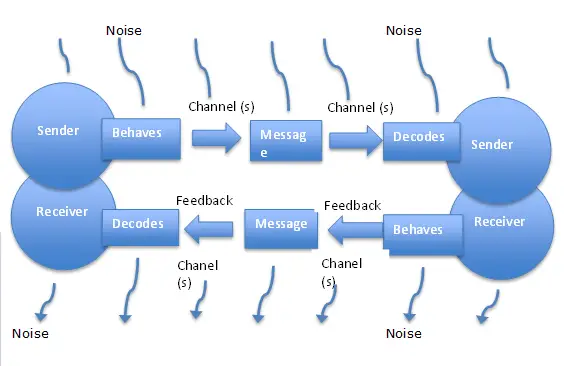Transactional model of communication is the exchange of messages between sender and receiver where each take turns to send or receive messages.
Here, both sender and receiver are known as communicators and their role reverses each time in the communication process as both processes of sending and receiving occurs at the same time.
The communicators can be humans or machines but humans are taken as communicators in this article to analyze general communication between humans. The model is mostly used for interpersonal communication and is also called circular model of communication.

Transactional Model Concept & Example
Transactional model is the process of continuous change and transformation where every component is changing such as the people, their environments and the medium used. Due to this, it assumes the communicators to be independent and act any way they want.
Since both sender and receiver are necessary to keep the communication alive in transactional model, the communicators are also interdependent to each other. For example, transactional communication is not possible if the receiver is not listening to sender.
The transactional model is the most general model of communication. Everyday talk and interactions are also a form of transactional model communication. It is more efficient for communicators with similar environment and individual aspects. For instance, communication between people who know each other is more efficient as they share same social system.
In transactional model, efficiency and reliability of communicated message also depends on the medium used. For example, the same message might not be perceived by a person the same way when it is send through a phone and when it is provided face to face. It is because of possible loss of message on a phone call or absence of gestures.
Factors Affecting Transactional Model
There are many factors directly or indirectly affecting the communication process in transaction model. These can be environmental noise or communication barriers. Environmental Noises can be Physical noise, physiological noise or psychological noise.
Transactional model relates communication to social reality of an individual or a group of people in social, cultural and relational contexts. Their responses cannot be predicted because they all have different backgrounds and mental conditions. Communication pattern depends on various factors such as physical, cultural, environmental, social, psychological, emotional, etc.
Cultural systems, social systems and relational situations are the most over-powering elements of the communication in transactional model, while physical and psychological context has considerable effect on the communication, enhancing or undermining it.
Social Context
Social context in communication refers to the norms, values, laws and other restrictions of a society to communicate within a specific limit. It also includes rules that bind people’s ability to communicate. Society shapes the way a person communicates. Some of the examples are: greeting people when meeting, thanking, apologizing, etc.
People can also learn communication from trial and error method, and its consequences ranges from social exclusion to embarrassment. This model also adds that it’s not just social reality that help people in the communication process but communication also shapes self and social reality in return. Communication is not only for exchanging messages but also to create and establish relationship helping people in the formation of a community.
Cultural Context
Cultural context is the lifestyle and identity of a person. Caste, class, race, ethnicity, gender, etc are the contexts which promotes communication. If two people are from the same cultural group, they will have better communication with each other.
Cultural identities are made by communication. It changes the communication pattern of a person. Marginalization of cultural groups oppress their communication with the other parts of the society. People become unsure of themselves when they communicate with intercultural groups. Some people also take it as unacceptable.
People have a closed mindset about the other groups of people they communicate with displaying the trait of Ethnocentrism. Experiences, attitudes, moods, cultural beliefs, social up-bringing, mindset, their sense of reality and many other factors affect the responses and the message exchange.
[Related Reading: Cultural Barriers to Communication]
Relational Context
Relational context of communication relates to relationship history and manners.
A person talks with an old friend differently than a stranger. Manners take the role of communication when it is with strangers. Manners come from pre-established norms and values, and are more scripted making interaction difficult. Type of relationship and the roles of people create differences in the way people communicate. Communication always occurs on the common systems of both the parties.
Criticisms of Transactional Model
- Without verbal response, the sender can not be sure that the receiver got the message as intended. Feedback is an important component in the communication process, especially in interpersonal communication as it gives a space to clarify misunderstandings.
- The transactional model gives the opportunity for a lot of noise because the communication is simultaneous. For example, when many people are talking at the same time in a meeting, the objective of the meeting will not be fulfilled.
Differences Between Transactional and Other Communication Models
| Transactional Model | Other Models |
|---|---|
| Used for interpersonal communication | Used for Intrapersonal, interpersonal, group or mass communications. |
| Senders and Receivers are known as Communicators, they interchange their roles | Senders and receivers are different people |
| Includes the role of context and environment | Role of context and environment are not mentioned in other models |
| Includes noise and communication barriers as factors | Not necessarily have the concept of noise |
| Talks about non-verbal communication | Ignores non-verbal communication |
| Simultaneous feedback | Feedback comes later in interaction model and is not included in linear model |
